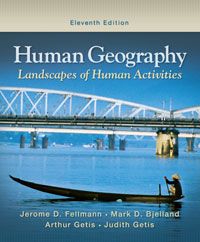1.
A) True B) False 2.
A) increasing at a high rate. B) increasing at a slow rate. C) being reversed in all cases. D) no longer taking place. 3.
A) Southern Great Lakes B) Coastal California C) Windsor-Montreal D) Vancouver-Willamette E) all of the above 4.
A) nucleated (hamlet and village) B) dispersed (isolated farmsteads) C) dense cities D) street villages 5.
A) 26,000 B) 16,000 C) 6,000 D) answer not given 6.
A) True B) False 7.
A) site characteristics B) situation characteristics C) both site and situation characteristics D) neither site nor situation characteristics 8.
A) True B) False 9.
A) top-down only B) bottom-up only C) two-way (up and down) D) none of the above 10.
A) True B) False 11.
A) Seoul B) London C) Los Angeles D) Cairo 12.
A) rank-size rule B) urban influence zone C) central place theory D) network cities rule 13.
A) True B) False 14.
A) True B) False 15.
A) concentric zone model B) sector model C) multiple-nuclei model D) galactice cities model 16.
A) ethnic status B) social status C) family status D) "A" and "B" E) "B" and "C" 17.
A) 1950s B) 1960s C) 1970s D) 1980s E) 1990s 18.
A) True B) False 19.
A) office space B) retail space in malls C) more jobs than residents D) all of the above E) none of the above 20.
A) True B) False 21.
A) Northeast and Middle West B) Southeast and Gulf of Mexico C) Great Plains and Atlantic East D) Mountain and Pacific West 22.
A) True B) False 23.
A) decreased significantly B) decreased slightly C) stabilized D) increased slightly E) increased significantly 24.
A) more sprawled B) equally sprawled C) slightly less sprawled D) considerably less sprawled 25.
A) True B) False 26.
A) True B) False 27.
A) CBD (central business district). B) hinterland. C) central place. D) threshold. 28.
A) manufacturing; basic B) retail; non-basic C) administrative; basic D) transport centers; non-basic E) administrative; non-basic 29.
A) threshold. B) range. C) spatial profit region. D) urban influence zone 30.
A) Over a long time period the density gradient is "squeezed" upward as it becomes shorter and steeper. B) Land rents tend to be highest for single family units on all gradients. C) Multi-story apartments are generally located 1-3 miles from the central business district (CBD) D) The larger the city the steeper the population density gradient.





